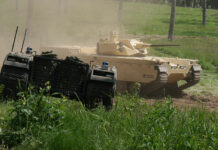Middle East Intelligence analysts have noticed the latest trend of hostile activities in southern Iraq, showing a marked increase in attacks on British forces. These culminated last May with the high-profile downing of the RAF Lynx helicopter in downtown Basrah city and especially the incited riots following shortly after the crash. British officers have expressed serious concern about the increasing influence and control of the Mahdi Army on Basra’s streets.last September, when troops were set on fire as they escaped from burning Warrior armoured vehicles attacked by petrol bombs.
The chief of the British Army General Sir Richard Dannatt has called for a pullout of British troops from Iraq “sometime soon”. Sir Richard might be issuing a “very public warning” to the next prime minister. In a sign that public opinion is hardening against Britain’s military presence in Iraq, 61% of voters say they want British troops to leave. In fact, there are already indications, that British “Operation Telic” contingent forces are re-deploying from down-town Basrah to more defensive positions around the perimeter, which may signal first preparations for a phased withdrawal early next year. The highly strategic Basrah region is not only the logistical vital supply gate for coalition forces in Iraq, but due to its strategic location, close to the Shat-al Arab waterway, could clear the way for an Iranian foray into the void.
Iran’s first objective implementing its aim would be controlling the strategic Shat-al-Arab waterway and Al Basrah province, which not only dominates all access routes in that region, but would place the US led coalition forces in Iraq in dangerous jeopardy, by virtually threatening their vital logistical supply life-line into central Iraq. Sofar, the only military force still preventing such a threat depended on the relatively limited military British contingent in Basrah. Fortunately, probably with some foresight, the south-central weak links that were the Ukrainian and Bulgarian contingents have recently been replaced by elements of the US 4th Infantry Division, forming up on the overall border region, preventing outflanking of British army positions north of Basrah. But any reduction, or even early withdrawal of the British contingent, would place these forces under severe pressure to stem a growing threat from Iranian-backed insurgency forces in that highly critical region. In order to achieve a strategic land-link to the Iraqi Shi’ite south, Iran must not only destabilise the Al Basrah region, but, first dominate the entire province with loyal elements, which will secure this vital land bridge for Iran’s ultimate aims.
In a recent restricted intelligence report, experts estimated that, while world attention is focusing on Iran’s nuclear ambitions and Iran President Mahmoud Ahmadinejad’s fierce rhetoric, the Islamic Revolutionary Guards Corps is quietly destablising southern Iraq, and unhinging British military control of Al-Basrah being its first objective. There are already indications, that Telic forces are re-deploying from down-town Basrah to more defensive positions around the perimeter, which may even signal first preparations for a phased withdrawal early next year.
Iranian influence in Iraq has significantly increased over the last year, but has become most pervasive in the Shiite south, where local militia, backed by IRGC have virtually consolidated their control over Al Basrah province and now dominate police, governate council, security apparatuses and even humanitarian organisations. These militias in the city have virtually eliminated nearly all the local opposition. In fact, it is well known to western intelligence community that Iranian revolutionary guard units are sponsors of the Mahdi Army of Moqtada al Sadr and the Badr Brigades of the Supreme Council for the Revolution in Iraq (SCIRI). They are the principal militias of the Shia communities of the south, and are now among the top three or four most powerful private armies in Iraq.
Although Shi’ite cleric Muqtada al-Sadr has repeatedly denied any relationship with the Iranian regime, he was reported visiting Iran in June 2003, where he met with high-level Iranian officials. More important, however is that Al-Sadr visited Iran again last January 2006, meeting with Supreme National Security Council Secretary Ali Larijani. Since that time, it appears relations have deepened, and some U.S. and Iraqi officials have alleged that Iran is now funding al-Sadr’s Imam Al-Mahdi Army.
Iraq’s leading Shi’ite political party, the Supreme Council for the Islamic Revolution in Iraq (SCIRI), was based in Iran for some 20 years prior to the downfall of the Saddam Hussein regime. SCIRI’s armed wing, the Badr Corps (now known as the Badr Organization) was trained by Iran’s Al-Quds Force, a special-operations unit of the Islamic Revolution Guards Corps. The Cairo-based weekly “Al-Ahram” claimed in 2005 that Iranian President Mahmoud Ahmadinejad played a role in the formation of the Badr Corps and hence wields considerable influence over the organization in its present activities.
Sources quoting from Israeli intelligence reports indicate that during the last months large shipments of advanced weapons have been smuggled into Iraq from Iran. Already last October London’s “Sunday Telegraph” reported that the notorious IRGC Al-Quds Force had established three main smuggling routes into Iraq through Al-Basrah and Al-Amarah from a base near Ahvaz, in Iranian Khuzestan. Officials estimate these latest deliveries including large numbers of Iran-modified SA-7 Strela ground-to-air missiles. One of such, could have been involved in shooting down the British helicopter over Basrah city.
During a recent closed conference held in Israel, oriental scholars and intelligence experts contemplated the new Iranian strategy over Iraq and its regional repercussions. Among the topics raised was the escalation of violence in southern Iraq and especially in the Al Basrah province, being one of the most strategic environments in the US led coalition campaign.
Last August, the newsweekly “Time” reported that the Iranian clerical regime began planning its infiltration to Iraq already late 2002, setting up strong military forces along the Iran-Iraq border. The newspaper said that thousands of people entered Iraq from Iran in the early days after the U.S-led invasion, including many agents of the Iranian security services.
Now over four years on, Iran appears to have entrenched its intelligence and paramilitary forces in Iraq, especially in the Shiite south, where, experts estimate, Iranian strategic goals are now focusing on the regional aims, to forward the so-called ” Shiite Crescent” strategy, which Jordan’s King Abdallah II mentioned last January. Analysts warn that among the possible Iranian goals in Iraq that have been propagated recently are, apart from preventing the formation of a pro-Arab, pro-U.S secularist regime; and driving U.S. forces from Iraq, their most important aim is to establish a secure strategic Iranian-controlled land route linking Iran to Syria, increasing leverage in Iran’s support of the Palestinian Hamas regime as well as their Shiite proxy, Hezbollah in Lebanon. Although the latter has been severly battered in the Second Lebanon war, its political prestige has grown substantially, threatening Fouad Siniora’s, western oriented grovernment with aim to establish a pro-Iranian, Shi’ite dominated Lebanon. Such a move would give the Tehran Ayathollas new impetus to realise their sofar unaccomplished ambition to propagate the Islamic dominance over the secular Middle East.
President Mahmoud Ahmadinejad’s strange letter to US president Bush, last Fall, should give analysts ample thought. The theological connotations, especially his closing phrase Vasalam Ala Man Ataba’al hoda ( “Peace only unto those who follow true path”), seems to signal, not only a sinister threat, but stern warning in writing, reminding orientalists of ancient historical idioms, not voiced by any Islamic leader since the capture of Constantinople in May 1453!
But what could become even more intriguing developments, at present, are still unconfirmed reports over a clandestine military operation under which Iranian Revolutionary Guard forces were quietly airlifted, early May, into Sudan, following a secret meeting between Omar Al-Bashir and Ayatollah Ali Khamenei.
It needs little imagination, glancing at the Middle East map, to indentify Iran’s latest strategic moves in this region: having creating ‘Hezbollahland’ in Lebanon South and the Beka’a Valley, increasing Iranian activity in the Palestinian West Bank and Gaza’s ‘Hamastan’ , active support to al Qaeda’s forward base in Sinai and now, if confirmed, establishing a military presence in east Africa within range of the strategic Red Sea shipping lanes.
















